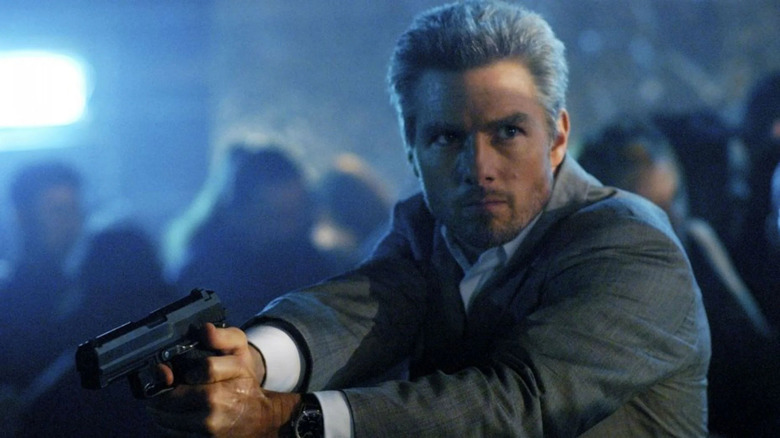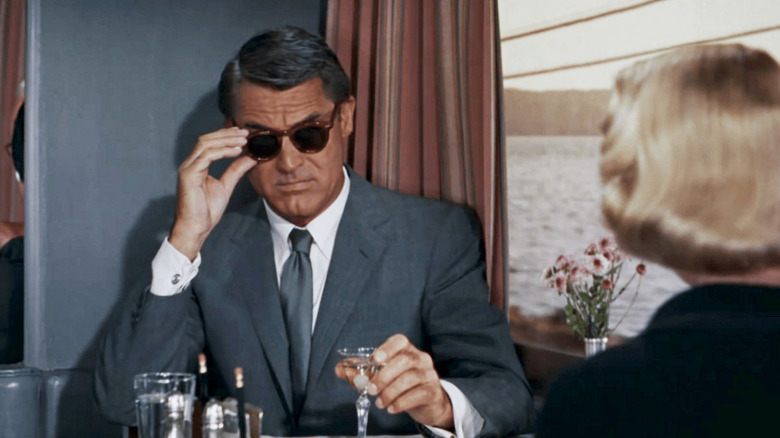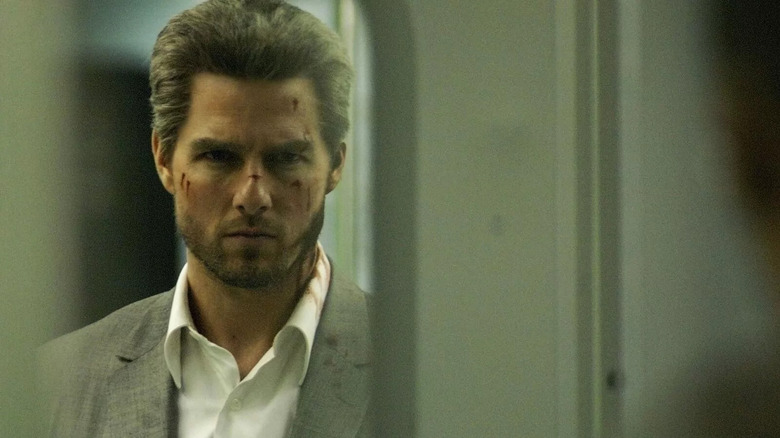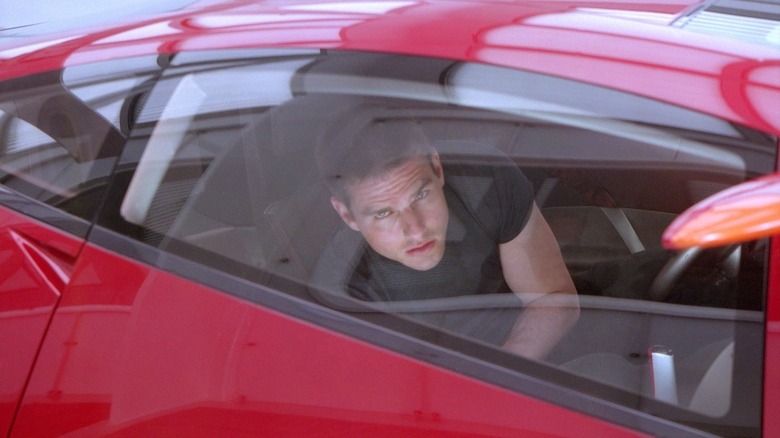Tom Cruise's Collateral Role Flipped A Hitchcock Classic On Its Head
One of the reasons 2004's "Collateral" was so successful critically and commercially is due to its classical nature. The film's premise is winningly old-school in its structure: Lifelong Los Angeles cabbie Max (Jamie Foxx) is hired by Vincent (Tom Cruise) to take the man to several different locations over the course of one night. Only two stops into the arrangement, Max discovers Vincent is a professional assassin, and the stops represent various targets the killer has been hired to hit. When the truth is revealed, Vincent not only holds Max hostage by continuing to make him drive him to his victims, but becomes involved with Max's life as a way of toying with, as Max fearfully realizes, the person he'll kill last.
While Michael Mann directed "Collateral" with professional grit and precision, there's another reason the film feels positively Hitchcockian: Vincent acts as a contrasting figure to Roger Thornhill, the character played by Cary Grant in Alfred Hitchcock's classic "North by Northwest." While the two men couldn't be more different in terms of their demeanor and ethics, their characters are connected in some intriguing ways. One involves their tastes in clothing.
The 'O' stands for nothing
In "North by Northwest," Roger Thornhill (Cary Grant) is a victim of Hitchcock's "wrong man" scenario, wherein a character is mistaken for someone else (whom we typically never see), forcing them to become involved in the plot. In Thornhill's case, his calling for a waiter at the exact wrong time causes some goons to believe he's really George Kaplan, a United States government agent who has become the target of Phillip Vandamm (James Mason), a spy working for the other side during the Cold War. Thornhill can't convince Vandamm or anyone else he's just a mere advertising executive, the baddies believing the man's plea of anonymity is simply an act.
Hitchcock and writer Ernest Lehman's deliciously layered joke is Thornhill's anonymity is both his weakness and his strength: It turns out there is no George Kaplan, as he's a fictional figure created by the U.S. government to distract Vandamm from the real American spy in his midst. When asked what his middle initial, "O," stands for, Thornhill shrugs and admits it stands for "nothing." It's a telling indication of the character's blank slate nature, which he'll have to change if he's to survive the mystery he's caught up in.
Thornhill's lightweight single-breasted gray flannel suit (which Grant allegedly picked out himself) perfectly encapsulates his character: stylish and charming enough to befit a leading man, but anonymous enough for him to be believably Everyman, the better to be mistaken for a nonexistent spy.
'Collateral's' Vincent flips the anonymity script
Where Roger Thornhill is a nobody plucked out of the crowd who becomes somebody, in "Collateral," Vincent is intentionally trying to remain anonymous, especially because his work really is covert and deadly. Thus, Vincent is wearing an updated version of Thornhill's gray minimalist suit. As BAMF Style observed in 2012, Thornhill "is supposed to be an innocent nobody being chased by assassins ... in 'Collateral,' Cruise plays an assassin tormenting an innocent nobody."
The contrasts between Vincent and Thornhill don't end there. While Thornhill's initials being "R.O.T." ("my trademark," Thornhill says ironically) are an indication that his anonymous lifestyle would ultimately be more damning and deadly than his adopting the identity of George Kaplan, Vincent uses his poisonous existential philosophy of being anonymous to both manipulate Max and justify his murderous job to himself.
Just a few minutes after hiring Max, Vincent espouses on the way anonymity pervades a city like L.A., telling the cabbie about how a man once died on the MTA and was riding around for six hours before anybody noticed his corpse. From there, Vincent keeps using such existential comparisons to further justify his actions, and the more he speaks the more he sounds like his entire personality comes from the books he reads and music he listens to rather than from himself. Eventually, the machine-like assassin loses control of the situation, underestimating Max — the "nobody" becomes somebody, a man he's ironically mentored during the whole night — and ends up an anonymous corpse riding on the MTA.
Cruise and 'North by Northwest' have more overlap than you realize
Of course, "Collateral" isn't the only Tom Cruise movie to reference Alfred Hitchcock. While the pioneering director died long before the actor became a star, Cruise's films have taken inspiration from Hitchcock in other sly ways as "Collateral" does. For instance, "Knight and Day" takes the "wrong man" idea and makes it into a "wrong woman," with Cameron Diaz's average citizen caught up with Cruise's superspy. And "Mission: Impossible – Rogue Nation" contains a sequence that pays homage to the concert hall assassination attempt in "The Man Who Knew Too Much."
Yet one set piece in 2002's "Minority Report" not only references Hitchcock's work, but realizes an idea the director originally had for "North by Northwest." According to Ernest Lehman, Hitchcock had a desire to do "the longest dolly shot in cinema history" with a sequence that would follow a car assembly line as a vehicle was constructed from scratch, and when the car was completed, "it's driven off the assembly line, and there's a dead body in the backseat."
While the scene never made it into "North by Northwest," director Steven Spielberg decided to include a version of it in "Minority Report," in which Cruise's on-the-run cop John Anderton (a "wrong man" character with a sci-fi twist) attempts to escape from his pursuers inside a car factory. When Anderton falls inside a car as it's being constructed, his enemies believe he's likely been crushed inside the body of the vehicle, only to see him sit up and speed away in a brand-new car.
While it's unlikely that Cruise would ever flat-out remake "North by Northwest," it's fun to consider what other remixed aspects of the film — and Roger Thornhill — might turn up in one of his future projects.



